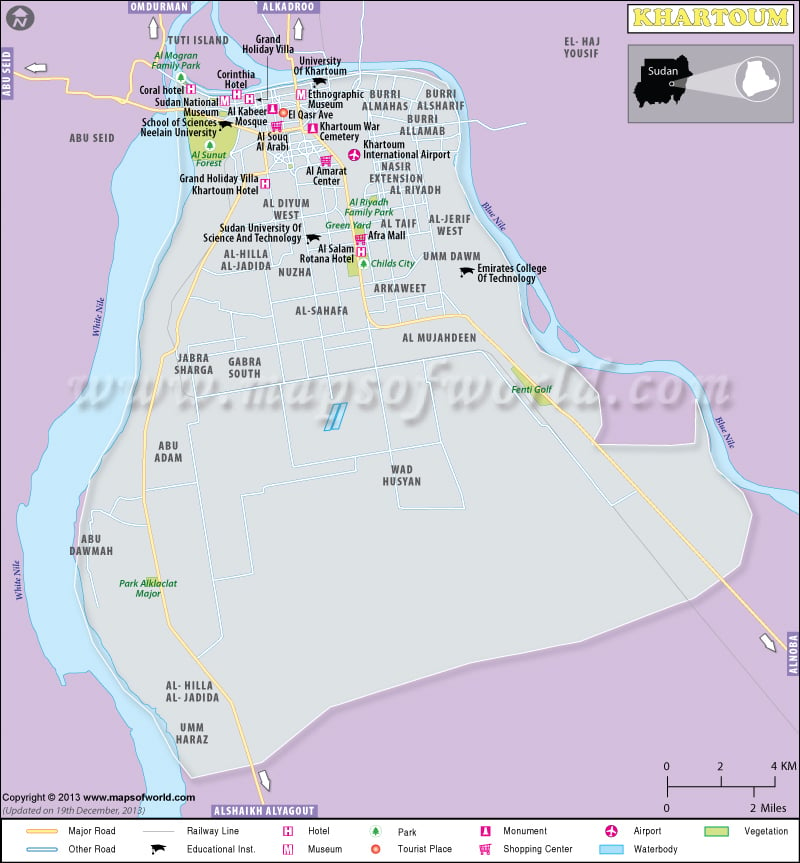Facts About Khartoum |
|
|---|---|
| Country | Sudan |
| State | Khartoum |
| Founded | 1821 |
| Area | 24 km |
| Population | 639598 (2008) |
| Lat Long Coordinates | 15°38′N032°32′E |
| Time Zone | (UTC+3) |
| area Code | 249 – 183 |
| Language | Arabic,English |
| Major Religion | Islam ( Sunni) |
| Point of interest | Temple of the God of Amun, Great Enclosure of Pyramids, Sudan Presidential Palace Museum, Pyramids of Gebel Barkal, Pyramids of Meroe, Dinder National Park, National Museum of Sudan |
About City
Khartoum is the capital of the Republic of Sudan. The port city is a tripartite metropolis comprising of the three cities of Khartoum, Omdurman and Khartoum North or Bahri. The Sudanese Government is situated in Khartoum proper which is the largest of the three cities. Khartoum was established by a man named Arbab Allaquad in 1691. The place was originally a forest, where Arbab established a mosque and a school for the study of the Holy Quran. This mosque was destroyed twice, but was rebuilt by the Egyptian king Farouq.
The present site of Khartoum, 15 miles north of the ancient city of Soba, was established in 1821 by Ibrahim Pasha. Initially, this city served as an outpost for the Egyptian army, which later grew as a center of trade. It became the administrative center for Sudan, and later its capital. This capital city suffered several political disturbances since then. In 1899 it became the capital of Anglo-Egyptian Sudan, after the British forces defeated the Mahdist forces defending the city.
Presently home to over five million citizens, Khartoum was the destination for the exodus of refugees fleeing conflicts in the neighboring nations in the 1970s and 1980s. English and Arabic are the prevalent languages in the city.
Geography
Khartoum is located at the confluence of the Blue Nile flowing west from Ethiopia and the White Nile flowing north from Lake Victoria. The point where the two Niles meet, known as the Al-Mogran, lies to the north of the bridge between Omdurman and Khartoum. The older part of Khartoum lies beside the White Nile, whereas the newer parts like Al-Amarat and Khartoum Two spread out to the south around the airport runway. The city is laid out mostly in the format of grids.
How to Reach (Transport)
The easiest way to reach Khartoum is by taking a flight to the Khartoum International Airport offered by various European, Middle Eastern or African airlines.
Reaching there by trains is another option as the city is well connected to the neighboring areas by the railways.
Once in the city, there are various transport options available like taxis, rental cars, three-wheeled taxis and boats. Walking is not a wise option as the city is too wide spread.
When to Visit
Khartoum experiences a hot desert climate which makes it one of the hottest cities in the world. The best time to visit this place is from November to March, when the temperatures are considerably lower than the usual, with little rainfall.
Fairs and Festivals
Being an Islamic country, Sudan observes holidays based on the Islamic calendar. There are, however, a few non-Islamic events as well that tend to celebrate the culture and the traditions of the natives.
- Mawlid an-Nabi celebrates the birth of the Prophet Muhammad in February. The streets get lined up with stalls of food and sweets, while the locals take an active part in dance and singing.
- Sham Al Nassim or the Spring Holiday is held in April, on the first Monday after Easter. The day is full of displays of dance, music and other activities.
- Eid al-Fitr marks the end of the month of Ramadan or the fasting period. The celebrations mainly include family gatherings over a veritable feast and exchange of gifts.
- Sufi Holiya Festival, celebrated in October, is the traditional Sufi dance and music festival. It is characterized by the gathering of people on the streets, irrespective of class or rank. The locals sing along to traditional hymns and take part in a parade through the city which exhibits the rich culture of the residents of Khartoum.
Points of Interest (Places to Visit)
The following are the places that attract tourists the most in Khartoum:
- Sudan National Museum is one of the best museums in the country. There are certain royal statues belonging to the kingdoms of Kush, Kerma and Meroe. There are also several medieval Christian frescoes on display.
- Sudan Presidential Palace Museum is located in the grounds of the Presidential Palace. It contains many relics that tell the history of Sudan’s administration and politics.
- Sudan Ethnographic Museum exhibits the traditions and cultures of the various ethnic groups of Sudan.
- The White Nile Bridge gives a majestic view of the confluence of the Blue and the White Nile.
- Souq Arabi is the commercial heart of the town. The huge market is spread over a vast area that provides the citizens with all their commercial needs.
- Besides these, there are various other attractions that must not be missed out by anyone travelling to Khartoum.
Accommodation
Accommodation facilities of various price ranges are available in Khartoum. Rotana Hotel is the only place that offers five-star facilities. Other luxury hotels in the region include Grand Holiday Villa, Coral Khartoum and Corinthia. Among the more affordable ones, Hotel Acropole is undoubtedly the best. The others in this price range include Dandas International Hotel, Lisamin Safari Hotel, El-Haramein, to name a few. Apart from these there is also the Blue Nile Sailing Club that provides travelers with tent camping facilities.

